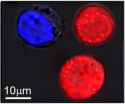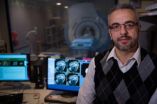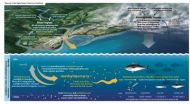(Press-News.org) TORONTO, Dec. 3, 2012—Mandatory rules such as restricting body checking can limit aggression and reduce injuries in ice hockey, making the game safer for young people, a new study has found.
Rule changes could be incorporated into existing programs that reward sportsmanship and combined with educational and other strategies to reduce hockey injuries, according to researchers at St. Michael's Hospital.
The need to address the issue is critical, said Dr. Michael Cusimano, a neurosurgeon. Brain injuries such as concussions frequently result from legal or illegal aggressive body checking and account for 15 per cent of all injuries to nine-to-16-year-olds. On some teams, up to one-quarter of players will suffer a concussion in a season. These injuries also reflect a pervasive "win at all costs" culture now seen in many sports.
"Given that brain injuries are so common and that they can have permanent effects, we need to introduce measures that we know have been shown to work to reduce the numbers of children and youth suffering these injuries in sport," said Dr. Cusimano, who has researched and written extensively about traumatic brain injuries such as sports concussions.
The researchers conducted a systematic review of 18 studies that evaluated interventions to reduce aggression-related injuries. The results of their review appear online today in the Canadian Medical Association Journal.
Thirteen of those studies evaluated mandatory rules in minor hockey leagues in Canada and the United States to lessen aggression. Of those, 11 found lower penalty or injury rates. Decreases in penalties ranged from 1.2 to 5.9 per game, while injury rates decreased three-fold to 12-fold.
In three studies of educational interventions, there were inconsistent effects on penalties and no significant effects on injuries. In two studies of cognitive behavioural interventions (changing thinking to change behaviour), reductions in aggressive behaviour were found.
Three of the13 studies on rule changes examined the Fair Play Program that makes sportsmanship a component of final league standings. Points are awarded to teams at the end of every season or tournament for staying below a pre-established limit of team penalties per game. Nine studies looked at the enforcement of rules prohibiting body checking and one examined the impact of legal punishment on the frequency of aggressive behaviour in the NHL.
"Rule changes essentially alter the culture of a sport and clearly define acceptable behaviour for players, coaches, parents and officials," said Dr. Cusimano.
He said that while educational programs can also do this to a certain extent, their effectiveness depends on the involvement of all stakeholders and a simultaneous change in their attitudes. For this to happen, educational interventions need to be effective, implanted repeatedly, have an obvious reward and have widespread application.
This has occurred in New Zealand, where the Rugby Union and the country's Accident Compensation Corp. developed a 10-point mandatory injury prevention program in 2001 that has resulted in a 13 per cent decrease in neck, back and spine injuries.
Dr. Cusimano said that introducing Fair Play Program rules with educational interventions and enforced rules hold promise in reducing injuries from aggressive behaviour. He said that Fair Play could have more impact if it incorporated stricter rule enforcement to penalize high-risk behaviour such as a head hit or check from behind. He suggested Fair Play could also remove the maximum number of penalties a team is allowed because critics say it encourages players to believe they are entitled to fill their quota and it potentially limits the number of penalties referees call in a high-stakes game.
###
About St. Michael's Hospital
St. Michael's Hospital provides compassionate care to all who enter its doors. The hospital also provides outstanding medical education to future health care professionals in more than 23 academic disciplines. Critical care and trauma, heart disease, neurosurgery, diabetes, cancer care, and care of the homeless are among the Hospital's recognized areas of expertise. Through the Keenan Research Centre and the Li Ka Shing International Healthcare Education Center, which make up the Li Ka Shing Knowledge Institute, research and education at St. Michael's Hospital are recognized and make an impact around the world. Founded in 1892, the hospital is fully affiliated with the University of Toronto.
For more information or to interview Dr. Cusimano, please contact:
Leslie Shepherd
Manager, Media Strategy
St. Michael's Hospital
Phone: 416-864-6094 or 647-300-1753
shepherdl@smh.ca
Inspired Care. Inspiring Science.
Study spells out hat trick for making hockey safer
Mandatory rules such as restricting body checking can limit aggression and reduce injuries in ice hockey
2012-12-04
ELSE PRESS RELEASES FROM THIS DATE:
Children with autism arrive at emergency room for psychiatric crisis 9 times more than peers
2012-12-04
BALTIMORE, Md. (December 3, 2012) – In the first study to compare mental health-related emergency department (ED) visits between children with and without autism spectrum disorders (ASD), researchers found that ED visits are nine times more likely to be for psychiatric reasons if a child has an ASD diagnosis. Published in the journal Pediatric Emergency Care (Epub ahead of print), the study found externalizing symptoms, such as severe behaviors tied to aggression, were the leading cause of ED visits among children with ASD. Importantly, the likelihood of a psychiatric ED ...
Curiosity shakes, bakes, and tastes Mars with SAM
2012-12-04
NASA's Curiosity rover analyzed its first solid sample of Mars in Nov. with a variety of instruments, including the Sample Analysis at Mars (SAM) instrument suite. Developed at NASA's Goddard Space Flight Center in Greenbelt, Md., SAM is a portable chemistry lab tucked inside the Curiosity rover. SAM examines the chemistry of samples it ingests, checking particularly for chemistry relevant to whether an environment can support or could have supported life.
The sample of Martian soil came from the patch of windblown material called "Rocknest," which had provided a sample ...
Alzheimer's researcher reveals a protein's dual destructiveness – and therapeutic potential
2012-12-04
A scientist at the University of British Columbia and Vancouver Coastal Health has identified the molecule that controls a scissor-like protein responsible for the production of plaques – the telltale sign of Alzheimer's disease (AD).
The molecule, known as GSK3-beta, activates a gene that creates a protein, called BACE1. When BACE1 cuts another protein, called APP, the resulting fragment – known as amyloid beta – forms tiny fibers that clump together into plaques in the brain, eventually killing neural cells.
Using an animal model, Dr. Weihong Song, Canada Research ...
Search for life suggests solar systems more habitable than ours
2012-12-04
SAN FRANCISCO—Scattered around the Milky Way are stars that resemble our own sun—but a new study is finding that any planets orbiting those stars may very well be hotter and more dynamic than Earth.
That's because the interiors of any terrestrial planets in these systems are likely warmer than Earth—up to 25 percent warmer, which would make them more geologically active and more likely to retain enough liquid water to support life, at least in its microbial form.
The preliminary finding comes from geologists and astronomers at Ohio State University who have teamed up ...
DNA analysis of microbes in a fracking site yields surprises
2012-12-04
SAN FRANCISCO—Researchers have made a genetic analysis of the microbes living deep inside a deposit of Marcellus Shale at a hydraulic fracturing, or "fracking," site, and uncovered some surprises.
They expected to find many tough microbes suited to extreme environments, such as those that derive from archaea, a domain of single-celled species sometimes found in high-salt environments, volcanoes, or hot springs. Instead, they found very few genetic biomarkers for archaea, and many more for species that derive from bacteria.
They also found that the populations of microbes ...
Multitasking plasmonic nanobubbles kill some cells, modify others
2012-12-04
HOUSTON – (Dec. 3, 2012) – Researchers at Rice University have found a way to kill some diseased cells and treat others in the same sample at the same time. The process activated by a pulse of laser light leaves neighboring healthy cells untouched.
The unique use for tunable plasmonic nanobubbles developed in the Rice lab of Dmitri Lapotko shows promise to replace several difficult processes now used to treat cancer patients, among others, with a fast, simple, multifunctional procedure.
The research is the focus of a paper published online this week by the American ...
Listen up, doc: Empathy raises patients' pain tolerance
2012-12-04
A doctor-patient relationship built on trust and empathy doesn't just put patients at ease – it actually changes the brain's response to stress and increases pain tolerance, according to new findings from a Michigan State University research team.
Medical researchers have shown in recent studies that doctors who listen carefully have happier patients with better health outcomes, but the underlying mechanism was unknown, said Issidoros Sarinopoulos, professor of radiology at MSU.
"This is the first study that has looked at the patient-centered relationship from a neurobiological ...
Women with sleep apnea have higher degree of brain damage than men, UCLA study shows
2012-12-04
Women suffering from sleep apnea have, on the whole, a higher degree of brain damage than men with the disorder, according to a first-of-its-kind study conducted by researchers at the UCLA School of Nursing. The findings are reported in the December issue of the peer-reviewed journal SLEEP.
Obstructive sleep apnea is a serious disorder that occurs when a person's breathing is repeatedly interrupted during sleep, sometimes hundreds of times. Each time, the oxygen level in the blood drops, eventually resulting in damage to many cells in the body. If left untreated, it ...
Mercury releases contaminate ocean fish: Dartmouth-led effort publishes major findings
2012-12-04
In new research published in a special issue of the journal Environmental Health Perspectives and in "Sources to Seafood: Mercury Pollution in the Marine Environment"— a companion report by the Dartmouth-led Coastal and Marine Mercury Ecosystem Research Collaborative (C-MERC), scientists report that mercury released into the air and then deposited into oceans contaminates seafood commonly eaten by people in the U.S. and globally.
Over the past century, mercury pollution in the surface ocean has more than doubled, as a result of past and present human activities such ...
Baby's health is tied to mother's value for family
2012-12-04
The value that an expectant mother places on family—regardless of the reality of her own family situation—predicts the birthweight of her baby and whether the child will develop asthma symptoms three years later, according to new research from USC.
The findings suggest that one's culture is a resource that can provide tangible physical health benefits.
"We know that social support has profound health implications; yet, in this case, this is more a story of beliefs than of actual family support," said Cleopatra Abdou, assistant professor at the USC Davis School of Gerontology.
Abdou ...
LAST 30 PRESS RELEASES:
Geometry shapes life
A CRISPR screen reveals many previously unrecognized genes required for brain development and a new neurodevelopmental disorder
Hot flush treatment has anti-breast cancer activity, study finds
Securing AI systems against growing cybersecurity threats
Longest observation of an active solar region
Why nail-biting, procrastination and other self-sabotaging behaviors are rooted in survival instincts
Regional variations in mechanical properties of porcine leptomeninges
Artificial empathy in therapy and healthcare: advancements in interpersonal interaction technologies
Why some brains switch gears more efficiently than others
UVA’s Jundong Li wins ICDM’S 2025 Tao Li Award for data mining, machine learning
UVA’s low-power, high-performance computer power player Mircea Stan earns National Academy of Inventors fellowship
Not playing by the rules: USU researcher explores filamentous algae dynamics in rivers
Do our body clocks influence our risk of dementia?
Anthropologists offer new evidence of bipedalism in long-debated fossil discovery
Safer receipt paper from wood
Dosage-sensitive genes suggest no whole-genome duplications in ancestral angiosperm
First ancient human herpesvirus genomes document their deep history with humans
Why Some Bacteria Survive Antibiotics and How to Stop Them - New study reveals that bacteria can survive antibiotic treatment through two fundamentally different “shutdown modes”
UCLA study links scar healing to dangerous placenta condition
CHANGE-seq-BE finds off-target changes in the genome from base editors
The Journal of Nuclear Medicine Ahead-of-Print Tip Sheet: January 2, 2026
Delayed or absent first dose of measles, mumps, and rubella vaccination
Trends in US preterm birth rates by household income and race and ethnicity
Study identifies potential biomarker linked to progression and brain inflammation in multiple sclerosis
Many mothers in Norway do not show up for postnatal check-ups
Researchers want to find out why quick clay is so unstable
Superradiant spins show teamwork at the quantum scale
Cleveland Clinic Research links tumor bacteria to immunotherapy resistance in head and neck cancer
First Editorial of 2026: Resisting AI slop
Joint ground- and space-based observations reveal Saturn-mass rogue planet
[Press-News.org] Study spells out hat trick for making hockey saferMandatory rules such as restricting body checking can limit aggression and reduce injuries in ice hockey



